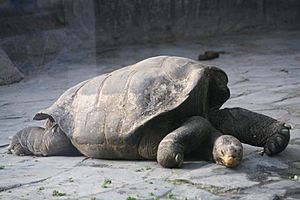Pinzón Island giant tortoise facts for kids
The Pinzón Island giant tortoise (scientific name: Chelonoidis niger duncanensis) is a special type of Galápagos tortoise. It lives only on Pinzón Island in the amazing Galápagos Islands. This makes it an endemic species, meaning it's found nowhere else in the world!
Quick facts for kids Pinzón Island giant tortoise |
|
|---|---|
 |
|
| Conservation status | |
| Scientific classification |
|
| Kingdom: | Animalia |
| Phylum: | Chordata |
| Class: | Reptilia |
| Order: | Testudines |
| Suborder: | Cryptodira |
| Family: | Testudinidae |
| Genus: | Chelonoidis |
| Species: | |
| Subspecies: |
C. n. duncanensis
|
| Trinomial name | |
| Chelonoidis niger duncanensis (Garman, 1966)
|
|
| Synonyms | |
|
|
Saving the Pinzón Tortoise Population
In the past, many tortoises were taken from Pinzón Island by explorers and sailors. This happened in the late 1800s and early 1900s.
Around the year 1900, black rats and brown rats arrived on the island. These rats ate the tortoise eggs and young hatchlings. Because of this, no new tortoises were born naturally for many years.
To help the tortoises, a special program started in 1965. Scientists began collecting tortoise eggs from Pinzón Island. They took the eggs to the Charles Darwin Research Station. There, the eggs were hatched safely, and the baby tortoises were raised.
Between 1970 and 1990, over 75% of these young tortoises survived. They were then released back onto Pinzón Island. Today, there are about 532 known Pinzón Island giant tortoises. They mostly live on the southwestern side of the island.
What Does This Tortoise Look Like?
The Pinzón Island giant tortoise is one of the smaller types of Galápagos tortoise. It has a brownish-gray shell, called a carapace. This shell is usually long and narrow at the front.
Its shell has a slightly curved shape, like a saddle. The front edge of the shell is a bit turned up. The back edge is also turned up and has a slightly jagged look.
See also
 In Spanish: Tortuga gigante de Pinzón para niños
In Spanish: Tortuga gigante de Pinzón para niños


